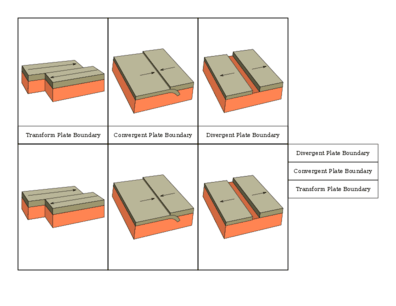Montessori Newsletter (Plate Tectonics)
Published on: August 17, 2008

Plate Tectonics and Continental Drift
Continental Drift
The crust of the earth isn't one solid piece, it's made of various
plates
. Land plates are called
continental plates.
Other plates are under the oceans, these are called
oceanic plates
.
These plates move, very slowly, over the surface of the earth. The oceanic plates are expanding through a process called oceanic spreading . Molten rock from the mantel and lower crust seeps up through cracks in the middle of the oceanic plates. Because of this, the other plates on top of the oceanic plates are also moved, like objects on a conveyor belt. In the softer plates, the rock is sheared by this force. In the harder rock, this tension builds up and is released in earthquakes.
When the continental plates move, it is called continental drift . A geologist, named Alfred Wegener, came up with the theory of continental drift in his book The Origin of Continents and Oceans . According to Wegener, primeval Earth (300 million years ago) consisted of a super continent called Pangaea. Eventually, it broke apart forming the present day continents and oceans.
Wegener believed that the modern continents were broken up from an ancient super continent because fossils of plant and animal life from separated places on the Earth showed similar life. Also, the continents fit like a jigsaw puzzle together.
Tectonic plates move in three different ways. Transform plate boundaries are when two plates slide past each other. A convergent plate boundary is one where one plate is subducted under the other, these boundaries often have mountains or volcanoes. The third type of plate boundary is a divergent plate boundary, this is the type of plate boundary that makes up the oceanic ridges.
Three part cards for the different types of plates
Pangea and The Ancient Continents
Long ago, there was one continent called Pangea, that consisted of all the continents pushed together.
Geologist now think that there were also previous super-continents and changes in the continents before Pangaea as well. The earliest known continent is known as Ur, it dates back to 3 billion years ago. Pangea was the supercontinent at the beginning of the Paleozoic, the first geologic era with complex land life.
Pangea eventually split into two other super continents, The northern part became Laurasia and the southern part became Gondwana. Eurasia and North America are the fragments of Laurasia. South America, Africa, India, Australia and Antarctica are the present day remnants of Gondwana.
Three part cards and matching cards for the continental plates that made up Pangea.
Three part cards and matching cards for the continental plates that made up Pangea.
Resources
- The great rift valley was formed through plate tectonics
-
PALEOMAP Project, maps of ancient earth and animations of plate tectonics
- More maps of ancient earth
- Information about plate tectonics in North America and more paleo maps
- Earth History and Plate Motion
- Continental Drift
-
Ancient Earth
-
The Great Lessons
- Pangea Continent
-
Pangea
Tags: